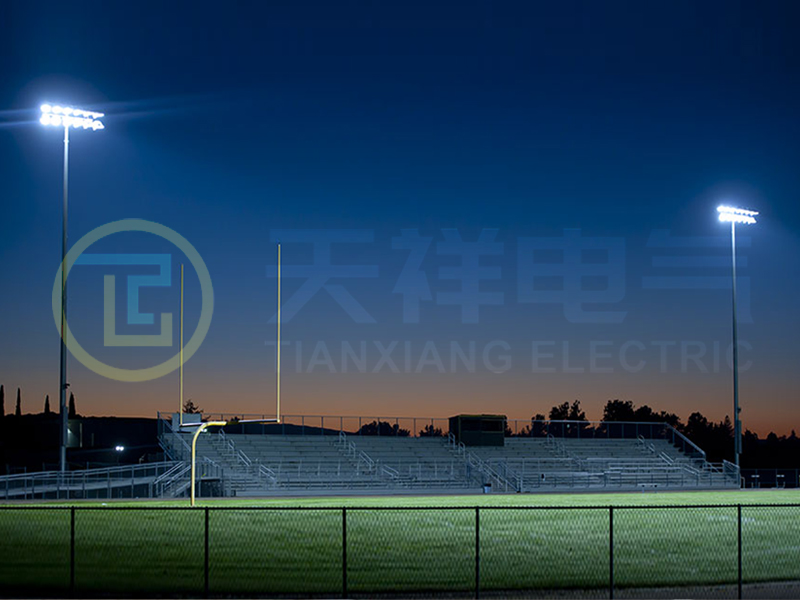In the world of outdoor lighting, high mast lighting systems have become a key solution for effectively illuminating large areas. These towering structures, which often stand 60 feet tall or more, are designed to provide broad coverage, making them ideal for applications as diverse as highways, sports centers, airports, and industrial sites. This article delves into the concept of high mast lighting coverage, exploring its importance, benefits, and considerations for optimal implementation.
What is high mast lighting?
High mast lighting refers to a system of tall poles with multiple luminaires that are strategically positioned to maximize illumination over a large area. The height of these poles allows for a wider spread of light, reducing the number of luminaires required to achieve the desired brightness level. Typically, high mast lighting is used in environments where safety and visibility are critical, such as parking lots, shipping yards, and public spaces.
Importance of high mast lighting coverage
The coverage area of high mast lighting is a key factor in determining its effectiveness. A well-designed high mast lighting system can illuminate a wide area, ensuring that every corner of the space is adequately illuminated. This is especially important in areas where visibility is critical to safety, such as:
1. Highways:
High mast lights are often installed along highways to improve visibility for drivers, especially at night or in inclement weather conditions. Well-lit roads reduce the risk of accidents and improve overall traffic flow.
2. Sports facilities:
Stadiums and sports centers require even lighting to ensure that athletes and spectators can see clearly. High mast lighting provides the necessary coverage, illuminating playing fields, tracks, and seating areas.
3. Industrial sites:
Warehouses and manufacturing plants can benefit from high mast lighting because it allows for efficient operation at night. Proper lighting improves worker safety and productivity.
4. Public spaces:
Parks, plazas, and other public areas can become crime hotspots if they are not adequately lit. High mast lighting ensures that these spaces are well-lit, helping to deter criminal activity.
Factors that affect the coverage area of high mast lights
Several factors affect the coverage area of a high mast lighting system, including:
1. Pole height:
Pole height directly affects the spread of light. Taller poles can cover larger areas, but this must be balanced with the intensity of the lamps used.
2. Luminaire type:
The choice of luminaire plays a major role in determining the coverage area. For example, LED luminaires are known for their efficiency and ability to produce bright, focused light, making them ideal for high pole applications.
3. Beam angle:
The beam angle of a luminaire determines how far the light spreads. Wider beam angles can cover a larger area but may result in reduced intensity, while narrower beam angles provide concentrated light but cover less ground.
4. Spacing between light poles:
The distance between high pole light poles is critical to achieving uniform lighting. Proper spacing ensures that there are no dark spots and that the entire area is effectively illuminated.
5. Environmental considerations:
Factors such as surrounding buildings, trees, and topography can all affect the effectiveness of high mast lighting. Performing a site assessment is essential to identifying potential obstructions and optimizing the location of the light poles.
Benefits of high mast lighting
The implementation of a high mast lighting system has many benefits:
1. Enhanced safety:
By providing uniform lighting, high mast lighting can significantly reduce the risk of accidents and improve the safety of pedestrians and drivers.
2. Cost-effectiveness:
While the initial investment may be higher than traditional lighting systems, high mast lighting requires fewer fixtures and less maintenance, resulting in long-term cost savings.
3. Energy efficiency:
Modern high mast lighting systems typically use LED technology, which consumes less energy and lasts longer than traditional lighting options.
4. Aesthetic appeal:
High mast lighting can enhance the visual appeal of an area, making it more attractive and encouraging community involvement.
5. Versatility:
High mast lighting can be suitable for a variety of applications, from lighting up sports fields to enhancing safety in industrial settings.
Conclusion
High mast lighting coverage is an important consideration for any outdoor lighting project. By understanding the factors that affect coverage and the advantages of high mast lighting systems, stakeholders can make informed decisions to improve safety, visibility, and efficiency. The future of high mast lighting is bright as technology continues to evolve, and innovations will further improve performance and sustainability. Whether it is for urban development, transportation infrastructure, or recreational facilities, high mast lighting remains an important part of creating a safer and more convenient environment.
Post time: Nov-15-2024





